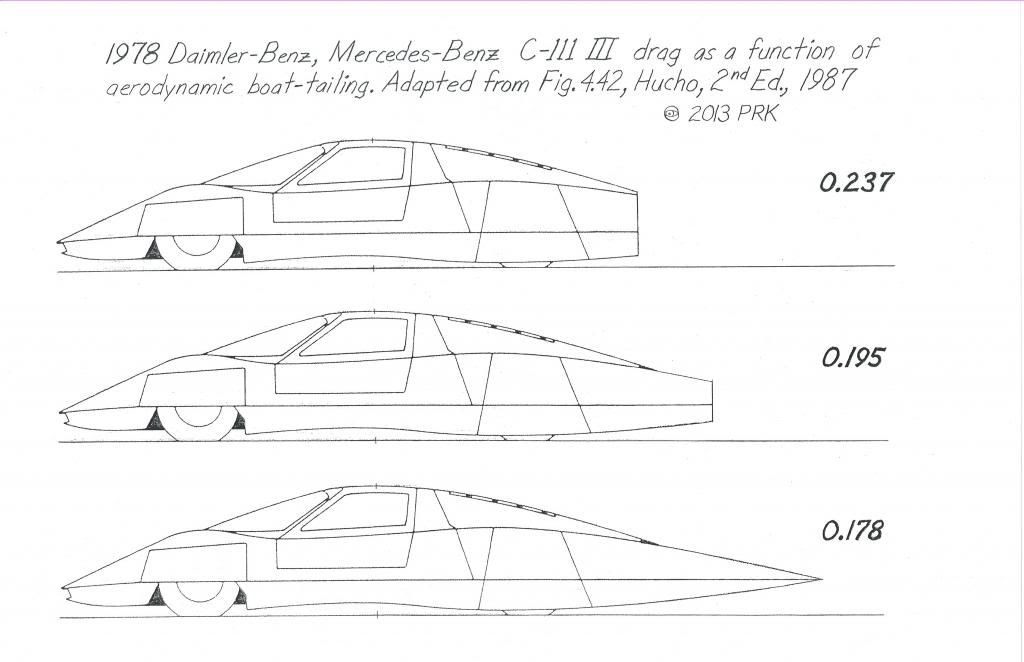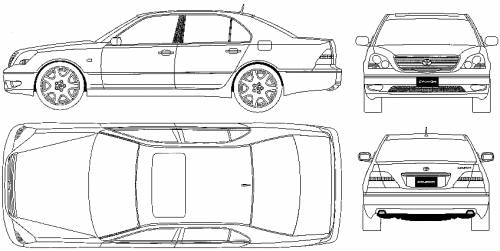 10-13-2013, 07:55 PM
10-13-2013, 07:55 PM
|
#11 (permalink)
|
|
Master EcoModder
Join Date: May 2008
Location: Maynard, MA Eaarth
Posts: 7,908
Thanks: 3,475
Thanked 2,953 Times in 1,846 Posts
|
It also could be taper (up) on the underside.
|
|
|

|
 Today Today
|
|
|
|
 Other popular topics in this forum...
Other popular topics in this forum...
|
|
|
|
 10-13-2013, 09:01 PM
10-13-2013, 09:01 PM
|
#12 (permalink)
|
|
fuel conserver
Join Date: Oct 2013
Location: Buffalo, NY
Posts: 76
Civic - '99 Honda Civic EX
Thanks: 48
Thanked 15 Times in 13 Posts
|
Could it be the C111 appears narrow, which if true means it has less frontal area? Maybe frontal area to length ratio has an effect.
__________________
'02 E-350 7.3 Diesel (Work Van)
'91.5 Cummins 4x4 (Old Blue)
'00 Jetta TDI 5spd
'22 Tundra TRD OR
'04 RX330
'05 Tacoma 4x4
|
|
|

|
 10-13-2013, 09:27 PM
10-13-2013, 09:27 PM
|
#13 (permalink)
|
|
(:
Join Date: Jan 2008
Location: up north
Posts: 12,762
Thanks: 1,585
Thanked 3,558 Times in 2,220 Posts
|
|
|
|

|
|
The Following 3 Users Say Thank You to Frank Lee For This Useful Post:
|
|
 10-14-2013, 07:18 AM
10-14-2013, 07:18 AM
|
#14 (permalink)
|
|
Master EcoModder
Join Date: Jul 2010
Location: Belgium
Posts: 4,683
Thanks: 178
Thanked 653 Times in 516 Posts
|
Quote:
Originally Posted by Cd

I was thinking over how that the Mercedes C111 seemed to be the 'perfect' shape aerodynamically, yet the numbers are rather unimpressive when compared to the new Mercedes passenger cars, and even some new cars from Mazda.
|
You get differences from one tunnel to another - and due to different sized models in the same tunnel.
Then there's the question on how the results were measured.
Rolling wheels , or not ?
And what wheels - thin, wide ?
Rolling road or not ?
Ride height ?
A wind tunnel is a bit like the EU tyre label, with OEM testing products on their own grounds rather than in the same or similar installation.
Within the laws and regulations, they adapt the testing grounds to their products.
Some tyres are quieter when tested by the OEM, then when the likes of ADAC.de compare many different ones in the same environment, they may turn out louder that tyres with a worse sound level ...
__________________
Strayed to the Dark Diesel Side

|
|
|

|
|
The Following User Says Thank You to euromodder For This Useful Post:
|
|
 10-14-2013, 06:34 PM
10-14-2013, 06:34 PM
|
#15 (permalink)
|
|
Master EcoModder
Join Date: Jan 2008
Location: Sanger,Texas,U.S.A.
Posts: 16,534
Thanks: 24,520
Thanked 7,436 Times in 4,817 Posts
|
Cd 0.22
Quote:
Originally Posted by Cd

I was thinking over how that the Mercedes C111 seemed to be the 'perfect' shape aerodynamically, yet the numbers are rather unimpressive when compared to the new Mercedes passenger cars, and even some new cars from Mazda.
Or perhaps, I am looking at it wrong. The Cds on the new cars are so much more impressive when you compare them to this ideal car.
Just look at the car from all angles and it should be perfect aerodynamically.
A low front end sloping upwards to a windshield curved which tapers back in plan form to a tear drop shape. No wipers or external protrusions. A tiny almost nonexistent grille. Full covered wheels - both front and back, and a curve which matches the aero template perfectly.
By looks alone, this car is a streamlined bullet with all of the right aero tricks. Perfect in fact.
Yet we see that the short tailed version of the car has a Cd of .237 .
By comparison, the new Mercedes has a Cd of .22 despite looking dumpy in comparison.


Does this make anyone else feel as though air is so unpredictable as to make modifying our cars nearly fruitless ?
Not that it would stop me all that much, but it is frustrating never the less.
Imagine taking a car and modifying it by lowering it, removing the mirrors, adding front and rear wheel covers, a blocked grille, a curved windshield, a full belly pan, as well as a tapered template matching shape, and all the other aero tricks, only to find out that your car has more drag than a car like the CLA with its gaping grille and side scoops, uncovered wheels and profile that is completely out of line with the template curve.  |
So the new M-B has caught up to the 1983 Ford 'Sierra' concept car.Or a little better than R.G.S.White's MIRA recipe car of 1968.
The C-111 III was a 'track' car and there were concessions to down-force to protect Hans Liebert and his driver team.
The nose was changed the very next year to the 'flachbau' blunt nose.
Hucho has criticized the C-111 III for its misuse of fineness ratio.
The plan-view reveals a lot about lost potential.
Kamm and Koenig -Fachsenfeld were only able to get Cd 0.21 out of the 'Template' when they ignored edge radii and body side camber integrating into the boat tail 'early' on the body,like the streamline half-bodies have.
When they did all the proper contours they got Cd 0.12 just like Walter Lay in 1933.
The C-111 looks good only in side elevation.It is not a proper 'Kombinationform'.The whole thing is a compromise.I drooled all over the thing in Stuttgart.I love it.But we can do better.Which is born out with the more 'modern' cars.
Blunt the nose,round those edges,narrow the rear axle and pull the body sides in to match the side contour of the greenhouse and you'll have a real 'hotty.'Or cold-rod,if you prefer. 
__________________
Photobucket album: http://s1271.photobucket.com/albums/jj622/aerohead2/
|
|
|

|
|
The Following 2 Users Say Thank You to aerohead For This Useful Post:
|
|
 10-14-2013, 06:43 PM
10-14-2013, 06:43 PM
|
#16 (permalink)
|
|
Master EcoModder
Join Date: Jan 2008
Location: Sanger,Texas,U.S.A.
Posts: 16,534
Thanks: 24,520
Thanked 7,436 Times in 4,817 Posts
|
discrepancies
Quote:
Originally Posted by HydroJim

are discrepancies in Cd testing to blame?
|
The M-B tunnel is the FKFS wind tunnel from next door at the Stuttgart Technical University where Kamm and Koenig-Fachsenfeld did their famous K-form research.
Calibration models have been tested in the USA,Asia,and Europe and there's an acceptable deviation in tunnel results which was published in the 1980s.
__________________
Photobucket album: http://s1271.photobucket.com/albums/jj622/aerohead2/
|
|
|

|
|
The Following 2 Users Say Thank You to aerohead For This Useful Post:
|
|
 10-14-2013, 06:50 PM
10-14-2013, 06:50 PM
|
#17 (permalink)
|
|
Master EcoModder
Join Date: Jan 2008
Location: Sanger,Texas,U.S.A.
Posts: 16,534
Thanks: 24,520
Thanked 7,436 Times in 4,817 Posts
|
low drag
Quote:
Originally Posted by Cd

Looking at the side taper of the CLR and LS 430, it doesn't seem there is much there.
For example, here is the LS 430 :

Mercedes designed that car with one goal in mind - low drag.
It's hard to believe that they would skip something so obvious if it made that big a difference.
( I do find the angle of plan taper on the C-111 to be quite excessive at the rear. Again, surely the engineers at Mercedes knew what they were doing and wouldn't have fuddged this up. ) |
Perhaps we need to assign parameters for 'low drag.'
Hucho says we can be looking at Cd 0.07 to 0.08.So we need some reference datum when we use 'low drag'.
Obviously the new M-B is not 'low drag.' It's just lower than previous models.
They've done a production-ready Cd 0.18 in the 90s.
__________________
Photobucket album: http://s1271.photobucket.com/albums/jj622/aerohead2/
|
|
|

|
 10-14-2013, 09:36 PM
10-14-2013, 09:36 PM
|
#18 (permalink)
|
|
Master EcoModder
Join Date: Jul 2011
Location: Ann Arbor, Michigan
Posts: 4,214
Thanks: 145
Thanked 2,827 Times in 1,983 Posts
|
__________________
George
Architect, Artist and Designer of Objects
2012 Infiniti G37X Coupe
1977 Porsche 911s Targa
1998 Chevy S-10 Pick-Up truck
1989 Scat II HP Hovercraft
You cannot sell aerodynamics in a can............
|
|
|

|
|
The Following User Says Thank You to kach22i For This Useful Post:
|
|
 10-15-2013, 04:51 PM
10-15-2013, 04:51 PM
|
#19 (permalink)
|
|
Master EcoModder
Join Date: Jan 2008
Location: Sanger,Texas,U.S.A.
Posts: 16,534
Thanks: 24,520
Thanked 7,436 Times in 4,817 Posts
|
effect
Quote:
Originally Posted by E.Roy

Could it be the C111 appears narrow, which if true means it has less frontal area? Maybe frontal area to length ratio has an effect.
|
Yes,very much so.It's the plan-view corollary to the side elevation effective fineness ratio.
Kamm and Koenig-Fachsenfeld devoted quite a bit of wind tunnel model studies to quantify the effects of the L/WXH ratio for both Jaray-form,and K-form car bodies.
How the body cross-section varies along the longitudinal axis,to and from the position of maximum cross-section is critical also.
Fast pelagic fish are a good model for streamlining.Their frontal area occurs in the first 1/3rd of their body length and the last 2/3rds cleans up the disturbance.
__________________
Photobucket album: http://s1271.photobucket.com/albums/jj622/aerohead2/
|
|
|

|
 10-15-2013, 05:06 PM
10-15-2013, 05:06 PM
|
#20 (permalink)
|
|
Master EcoModder
Join Date: Jan 2008
Location: Sanger,Texas,U.S.A.
Posts: 16,534
Thanks: 24,520
Thanked 7,436 Times in 4,817 Posts
|
and still have an unimpressive
Quote:
Originally Posted by Cd

It all comes down to " optimization ", but as amateurs without wind tunnels, what is the best that we can do besides guess what the air is doing ?
You could do all the right aero tricks to a car and still have an unimpressive Cd
I personally think that the best tool that we have is tuft testing, since it shows the problem areas in our testing.
That, and of course CFD and lots and lots of A-B-A testing .
|
The point I would want to emphasize,is that if we mimic what has proven itself in tunnel after tunnel study,that we won't stray too far afield when we make it to the gas station.
There is such a vast body of empirical data to work with.If we stay with the good science we should be able to achieve whatever we target.
Personally,I've never had a disappointment as long as I followed the science and physics.I've had failures of course,but they were all borne out of ignorance.Which is no sin. 
__________________
Photobucket album: http://s1271.photobucket.com/albums/jj622/aerohead2/
|
|
|

|
|